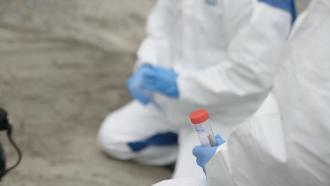Media release
From:
Make-up of a two-million-year-old ecosystem reconstructed from ancient DNA *IMAGES* *PRESS BRIEFING*
An analysis of the oldest ancient environmental DNA recovered to date has been used to build a picture of an ecosystem in North Greenland, including the animal and plant species present, approximately two million years ago. The findings, published in Nature, allow us to explore and understand an ancient ecosystem to an extent not previously possible and provide insights into an ecosystem that has no modern equivalent.
The Kap København Formation, located in Peary Land, North Greenland, is a polar desert. Previous research suggests that the region had a much warmer climate around 2–3 million years ago with temperatures 11–19 °C warmer than today. However, the biological communities inhabiting the Arctic during this time remain poorly understood because vertebrate fossils are rare.
Eske Willerslev and colleagues extracted and sequenced DNA from 41 organic-rich sediment samples taken from 5 different sites within the Kap København Formation. From this DNA, the authors were able to build a picture of the ancient ecosystem: an open boreal forest with a mixed vegetation of poplar, birch and thuja trees, as well as a variety of Arctic and boreal shrubs and herbs. The DNA record also confirms the presence of hares, and mitochondrial DNA from the site points to the presence of other animals including mastodons, reindeer, rodents and geese. Ancient DNA was also recovered from marine organisms and suggests the presence of a population of the Atlantic horseshoe crab (Limulus polyphemus). The authors propose that this could mean that there were warmer surface water conditions in the Early Pleistocene at Kap København, which is consistent with previous estimates.
The authors conclude that their findings demonstrate the potential to use ancient environmental DNA to track the evolution of biological communities two million years ago.
B-roll and further images available on request from press@nature.com
**Please note that an online press briefing for the papers below will take place UNDER STRICT EMBARGO on Tuesday 06 December at 3pm London time (GMT) / 10am US Eastern Time**
Authors Eske Willerslev, Kurt Kjær, Nicolaj Larsen, Karina Sand, Mikkel Pedersen, and Bianca DeSanctis will discuss the research. This will be followed by a Q&A session.
To attend this briefing you will need to pre-register by following the link here. Once you are registered, you will receive an email containing the details for the briefing. You will also be provided with the option to save the details of the briefing to your calendar.
Multimedia





 Australia; International; WA
Australia; International; WA


